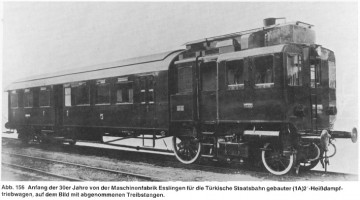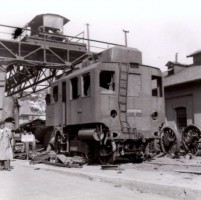Steam Railcar
- Otomotris 1 to 3
- Axle type: (1A)'2'
- Quantity: 3
- First year: 1932
- Manufacturer: Esslingen
History & description
Steam railcars were invented in the mid 19s century as an economic solution to operate lightly used branch line. Some were also used on urban or suburban lines as an alternative to push-pull operations, something with is difficult to do with steam engines.
In Europe, this technology remained a niche for very specific cases and was never a mainstream usage. It was quickly superseded by the diesel railcar, a vehicle that finally delivered reduced operational cost. This occurred in the mid-1930s when the first generations of diesel railcars started to be mass produced. Against this background, TCDD ordered 3 steam railcars to Maschinenfabrick Esslingen in 1932. These railcars incorporate all the best design at a time these steam railcars climaxed from a development perspective.
The frame is articulated in two elements. On element is like a B type steam locomotive, carrying the engine and the boiler. The other element is a passenger car, resting on a bogie at one end, and on the power truck at the other end. This design allows a good separation of the passengers from the engine noise, odors and vibrations. It allows also separation of the locomotive for maintenance purpose.
The boiler is a vertical, medium pressure and able to deliver 400 hp. This power allows for an operational of 75km/h on flat line with a 20 tones trailer. The boiler has a preheater part were the water temperature is raised to 200°C. It then goes into an evaporator part where the steam raises to 400°C. This design allows for quick change of power during starts or during climbs. The coal bunker is placed higher to the firebox allowing for a semi-automatic feeding of the fire. The water tank capacity of 3,2m3 is designed for autonomy of 100km under normal operating conditions.
The car has a driving position as both ends and can be operated in either direction, avoid the need for turning. Both driving positions have all the equipment to monitor the boiler: water level, manometer and pyrometer as well as the usual equipment for driving: regulator, reversing, brake. A single man can operate the railcar. The passenger side has 56 seats in 3 classes, a mail and a luggage compartment and toilets.
Test & Service
During tests carried out in Germany before delivery, the railcar reached a top speed of 108 Km/h on a flat line. It was able to accelerate to 92 km/h on a 10‰ climb, to 83km/h on a 14‰ climb and to 60 km/h on a 22,5‰ climb. During these tests, the engine reached 430 hp. The coal and water consumption where found to be within the expectations and 25% more efficient than previously built steam railcars.
The service in Turkey is not known. It seems the units were in Izmir area at first and then transferred to Adana area. We have photographic evidences the units were partially demolished in 1955. It is very likely these fine machines where quite delicate to maintain properly and must have had a low reliability, quickly replaced by diesel railcars, the first of which arrived in Turkey in 1934.
| TCDD Number | Manufacturer | Number/Date |
|---|---|---|
| 1 | Esslingen | 4238/1932 |
| 2 | Esslingen | 4239/1932 |
| 3 | Esslingen | 4240/1932 |
Pictures

A rare view of this odd unit. Scan Eljas Pölhö from "Dampftriebwagen" by Rolf Ostendorf |

Otomotris 3 partially demolished in Eskişehir Works, 9th June 1955. Photo Alan Swale |
Main characteristics
| Cylinder diameters | 250mm |
| Piston stroke | 500mm |
| Driving wheel dia. | 1400mm |
| Carrying wheel dia. | 1000mm |
| Engine wheel base | 3600mm |
| Boggie wheel base | 3600mm |
| Overall wheel base | 17,37m |
| Heating surface | 14.7m2 |
| Water heater surface | 22.3m2 |
| Super heating surface | 10.1m2 |
| Boiler presseur | 12 bar |
| Grate area | 1m2 |
| Water capacity | 3.2m3 |
| Coal capacity | 0,8T |
| Railcar weight empty | 49T |
| Railcar weight loaded | 58 T |
| Engine axle load | 17 T |
| Car Axle load | 16 T |
| Max speed | 75km/h |
Notes & references
- Technical data is from of Die Lokomotive, November 1932 issue (In German 2MB pdf document).
